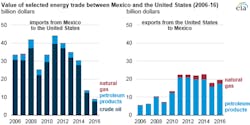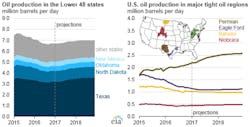Rice takes deeper look at unconventional oil and gas
Rice University engineers George Hirasaki and Walter Chapman are combining nuclear magnetic resonance with molecular dynamics simulations to help better characterize the contents of organic shale. The team seeks to understand how oil and gas molecules, water and rocks interact at the nanoscale level in an effort to make extraction of hydrocarbons through hydraulic fracturing more efficient. Their method to analyze shale samples and validate simulations is detailed in this month’s Journal of Magnetic Resonance.
Graphic courtesy of the EIA
US energy exports to Mexico exceeds value of energy imports from Mexico
Mexico’s sales of crude oil to the U.S. and U.S. net exports of refined petroleum products to Mexico have historically been the driving force of energy trade between the two countries, according to the EIA. Mexico’s exports of crude oil to the U.S. were the most valuable component of bilateral energy trade through 2014. But the bilateral energy trade situation with Mexico chanced significantly in 2015 and 2016, with the value of U.S. energy exports to Mexico exceeding the value of U.S. energy imports from Mexico.
Leak detection market for oil and gas growing
The oil and gas leak detection market was valued at $2.10 billion in 2015 and is expected to climb to $3.38 billion by 2022 at a compound annual growth rate of 6.9 percent. Meanwhile, acoustic/ultrasonic is expected to rule the leak detection market between 2016 and 2022, according to online market research group reportsnreports.com.
Increasing incidents of leakages in the oil and gas pipelines and storage tanks at production facilities, development and expansion of existing pipelines and construction of new pipelines, and stringent government regulations pertaining to the implementation of leak detection systems are all credited with spurring growth in the leak detection market.
Natural gas-fired generating capacity likely to increase
Annual net additions in natural gas capacity could be at their highest levels since 2005 if the electrical industry follows through on its plans to increase natural gas-fired generating capacity by 11.2 gigawatts (GW) in 2017 and 25.4 GW in 2018. The U.S. Energy Information Administration (EIA) is forecasting based on information it received. Combined, these additions would increase natural gas capacity by 8 percent rom that existing at the end of 2016.
Rail provides outlet for growing Appalachian HGL production
The East Coast region relies most on rail to transport hydrocarbon gas liquids (HGL), according to the EIA’s new data series published in Movements of Crude Oil and Selected Products by Rail. The HGL-by-rail series include shipments of propane, propylene, normal butane and isobutane between and within Petroleum Administration for Defense District (PADD) regions and to and from Canada. View full report here.
HGL-by-rail data adds transparency to rapidly changing markets
In an effort to add more transparency to market supply and demand dynamics, the EIA has added information on rail movements of propane, propylene, normal butane and isobutene to its monthly petroleum data. These four products make up the majority of HGL moved by rail. This HGL-by-rail data series are developed using information provided by the U.S. Surface Transportation Board. See the full report here.
Graphic courtesy of the EIA
Texas, ND expected to drive production gains through 2018
U.S. crude oil production is expected to increase an average of 8.9 million barrels per day (b/d) in 2016 to an average of 9.3 million b/d in 2018, thanks to gains in major U.S. tight oil-producing states Texas, North Dakota, Oklahoma and New Mexico, according to the EIA Short-Term Energy Outlook for January. Among those states, Texas and North Dakota are expected to continue to lead production of crude oil because of large amounts of economically recoverable resources in the Eagle Ford, Permian and Bakken regions.




